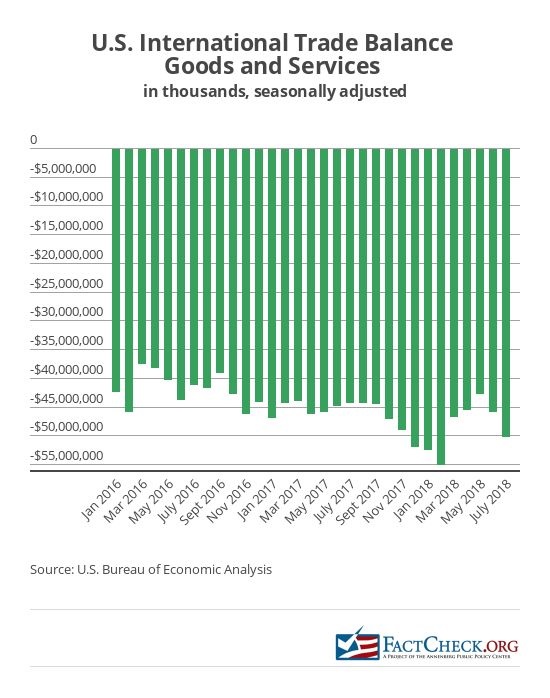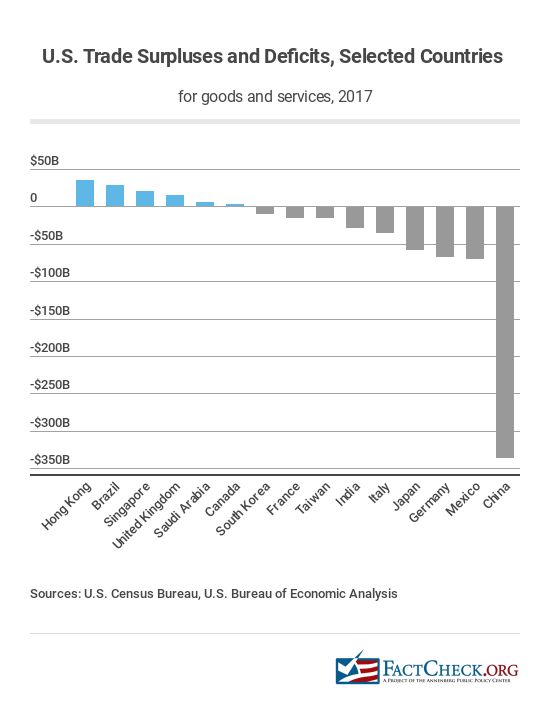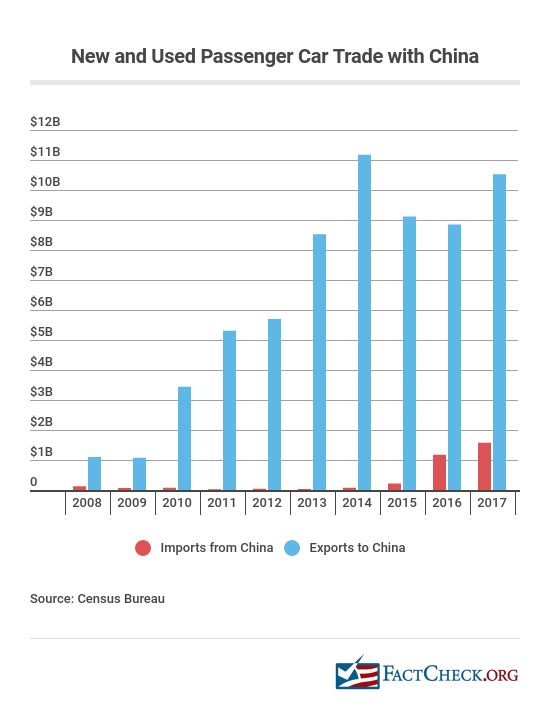At a rally on Sept. 20, President Donald Trump returned to a regular applause-line, promising the crowd in Las Vegas, “We’re renegotiating the worst trade deals ever made by any country at any time.”
The idea that the U.S. has long been taken advantage of in trade deals with other countries has been a staple of Trump’s speeches, both during the campaign and in his tenure as president. But his rhetoric often has been at odds with the facts.
Here we highlight a number of key statistics about trade, and summarize some of the stories we have written when these facts have been misrepresented. It is part of a larger effort by North American fact-checkers to highlight various facts about trade and international commerce, timed around the 25th anniversary (roughly) of the completion of negotiations on the North American Free Trade Agreement. The work of other fact-checking organizations can be found here.
Fact: The total U.S. trade deficit has gone up slightly, by $3.2 billion or 6.8 percent, since January 2017.
In his 2018 State of the Union address, Trump said: “America has also finally turned the page on decades of unfair trade deals that sacrificed our prosperity and shipped away our companies, our jobs, and our nation’s wealth.” But the trade deficit at that time had increased during his presidency.
That’s still the case.
The U.S. trade deficit for goods and services was $46.9 billion in January 2017, the month Trump took office. In July 2018, according to the latest figures available from the Bureau of Economic Analysis, it was $50.1 billion. That’s an increase of $3.2 billion. The monthly figures are seasonally adjusted.
Comparing January through July of this year with the same six-month period in 2017, the trade deficit is up by $22 billion. And it’s up $49.4 billion from the first six months of 2016.
In August, Trump was wrong when he said the trade balance had improved by $52 billion from the first quarter of 2018 to the second quarter. The real figure is $20 billion. The monthly deficit did drop from March through May of this year, but it went back up in both June and July.
“Trump’s Trade-Balance Mistake,” Aug. 1
“Trump’s Numbers (Second Quarterly Update),” July 11
“FactChecking Trump’s State of the Union,” Jan. 31
Fact: The U.S. does not have a deficit with each of its trading partners.
The U.S. had an overall trade deficit of $552 billion in goods and services in 2017, but it didn’t have a negative balance with “every country,” as Trump has claimed before.
The U.S. had positive balances with six of 15 trading partners the Census Bureau highlighted: Hong Kong ($35 billion), Brazil ($28.5 billion), Singapore ($20.3 billion), the United Kingdom ($15.6 billion), Saudi Arabia ($5.3 billion) and Canada ($2.8 billion).
“FactChecking the 11th GOP Debate,” March 4, 2016
Fact: NAFTA was negotiated and signed in 1992 by President George H.W. Bush.
Even the facts about the origins of NAFTA have been bungled over time. During the presidential campaign, Trump repeatedly blamed former President Bill Clinton, saying it was the Democrat, and husband of Trump’s presidential opponent, who signed it. “It was his baby,” Trump said.
In fact, NAFTA was negotiated and signed by President Bill Clinton’s predecessor, President George H.W. Bush. It is true that Clinton signed the bill enabling NAFTA in 1993; however, it took Republican congressional support to get that bill to his desk. The Senate passed the North American Free Trade Agreement Implementation Act, 61-38, in November 1993, with 34 Republican votes, and the House passed it 234-200, with 132 Republican votes.
“Trump on the Stump,” Sept. 28, 2016
“Groundhog Friday,” July 1, 2016
“Trump’s Attack on Clinton’s Character,” June 22, 2016
Fact: The Congressional Research Service says NAFTA’s net overall effect on jobs has been “relatively modest.”
Trump has repeatedly blamed NAFTA for hollowing out American manufacturing. But he’s not the only one. Sen. Bernie Sanders, a former Democratic presidential candidate, claimed that NAFTA cost the U.S. 800,000 jobs, and a campaign mailer from Barack Obama back in 2008 claimed “one million jobs have been lost because of NAFTA.”
But economic studies say NAFTA’s net impact on U.S. jobs has been relatively small.
There has been a 24 percent drop in manufacturing jobs since December 1993, the month before NAFTA took effect, when there were 16.8 million manufacturing jobs, according to the Bureau of Labor Statistics. See the BLS chart below. (After bottoming out at around 11.5 million jobs in early 2010, manufacturing jobs have steadily climbed back to 12.7 million.)

However, overall jobs have gone up by 33 percent since December 1993, from 112.3 million to 149.3 million.
Economists have, of course, debated the effects of the trade agreement. But overall, economists have found the net effect on jobs from NAFTA has been small. A 2015 report from the nonpartisan Congressional Research Service called the impact “relatively modest.”
That report also noted that it was difficult to gauge the overall economic impact “since trade and investment trends are influenced by numerous other economic variables, such as economic growth, inflation, and currency fluctuations.” CRS said: “The agreement likely accelerated and also locked in trade liberalization that was already taking place in Mexico, but many of these changes may have taken place without an agreement.”
“Trump’s Attack on Clinton’s Character,” June 22, 2016
“Trump on the Stump,” Sept. 28, 2016
“Trump’s Foreign Policy Speech,” April 28, 2016
“More NAFTA Nonsense,” March 3, 2008
Fact: The official U.S. trade statistics show that the United States had a trade surplus of $2.8 billion in goods and services with Canada in 2017.
Trump often claims that the U.S. has a trade deficit with Canada, sometimes saying it is $17 billion and other times $100 billion. In fact, the official U.S. trade statistics show the U.S. hasn’t had a trade deficit with Canada in goods and services since 2014. And the trade surplus — slight as it is — has continued for the first two quarters of 2018.
According to the Census Bureau, which is within the U.S. Department of Commerce, the U.S. had a total trade surplus with its neighbor to the north of $4.2 billion in 2015, $7.4 billion in 2016 and $2.8 billion in 2017.
For the first two quarters of 2018, the U.S. has maintained a $3.3 billion surplus, according to the Bureau of Economic Analysis, which is also within the Department of Commerce. (The BEA and Census Bureau jointly release monthly trade statistics on goods and services, as explained on the BEA’s website.)
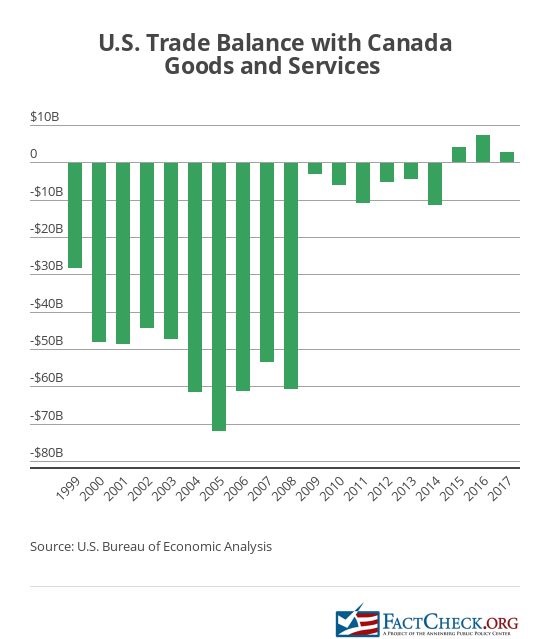
“Trump’s Canadian Trade Tale,” March 15
“Trump Garbles Canadian Trade Stats,” June 13
Fact: The U.S. trade deficit in goods and services with Mexico was nearly $69 billion in 2017.
Trump often mentions that the U.S. has a trade deficit with its southern neighbor, which is true. That has been the case each year going back to 1999, according to BEA data.
But the amount is not “over $100 billion a year,” as Trump has claimed. It also is not a particularly “large” trade deficit, as he has also said before.
Census Bureau data show that the U.S. trade deficit in goods and services with Mexico was $69 billion in 2017, up from $63 billion in 2016 and $58 billion in 2015. And it was almost $36 billion through the first two quarters of this year.
Still, that’s relatively modest.
The $337 billion trade gap with China was almost five times larger in 2017, for example. And last year’s deficit amounts to just 11 percent of the total two-way U.S. trade with Mexico, which is our third-largest trading partner after China and Canada. In contrast, the deficit with China amounts to 47 percent of the total trade between the two countries.
 “Trump’s Trade Mistweet,” March 8
“Trump’s Trade Mistweet,” March 8
“FactChecking Trump’s Nashville Rally,” May 30
Fact: The United States had a trade surplus with China for passenger cars of $8.9 billion in 2017.
Exports of cars from the U.S. to China totaled $10.5 billion, while imports from China were $1.6 billion in 2017. Yet Trump claimed at a roundtable discussion in April that China “won’t take” U.S. cars.
The president correctly cited the countries’ respective tariffs, saying that China puts a 25 percent tariff on cars coming from the United States, while the tariff on Chinese exported passenger cars to the U.S. is 2.5 percent.
But China is the second-largest market for U.S. exported cars, behind Canada, according to data from the Census Bureau’s foreign trade division.
Experts told us that there has been an ongoing dispute with China over its requirement that U.S. companies manufacturing cars in that country enter into a joint venture with a Chinese company. Still, foreign companies have opened for business in China, including some from the U.S.
Kristin Dziczek, vice president of industry, labor and economics at the Center for Automotive Research, an independent, nonprofit research center, told us the trade surplus with China for cars is expected to become a deficit by 2022. However, it won’t be Chinese-branded vehicles fueling the switch. Instead, international producers will send Fords, Buicks and Volvos to the United States.
“Trade Surplus in Cars with China,” April 11
Fact: In fiscal 2017, U.S. agricultural exports totaled $140.5 billion, the third-highest amount on record, and the agricultural sector posted an annual trade surplus of $21.3 billion.
Trump more than once has blamed bad trade deals for U.S. farmers’ financial problems in recent years. But agricultural economists have told us that trade has been a “bright spot” for an industry that has been in decline after record income levels from 2011 through 2014.
U.S. agricultural exports totaled $140.5 billion in fiscal year 2017 — increasing by $10.9 billion, or 8.4 percent, from the previous year to the third-highest amount on record, according to the U.S. Department of Agriculture. China ($22 billion), Canada ($20.4 billion) and Mexico ($18.6 billion) were the United States’ three largest export customers.
The U.S. is the world’s second-largest agricultural trader after the European Union, and exports are responsible for 20 percent of U.S. farm income, according to the USDA.
And, as it has done since 1960, the U.S. agricultural sector posted an annual trade surplus — $21.3 billion in fiscal 2017, up almost 30 percent from $16.6 billion in fiscal 2016.
The USDA charts below show agricultural trade since 1990.
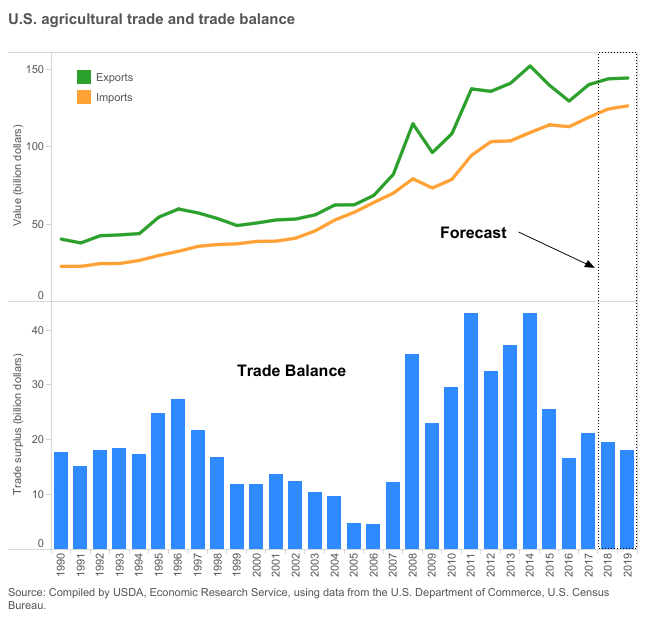
“Trump Distorts Facts on Agricultural Trade,” July 3
“Trump’s Specious Trade Tweets,” July 20
Fact: In litigation brought to the World Trade Organization for dispute resolution, the U.S. wins the vast majority of cases it brings, and it loses most of the cases brought against it. That’s generally how other countries fare as well.
While Trump regularly ridicules NAFTA as “one of the worst trade deals ever in history,” he reserves the top of his worst-list for the World Trade Organization, an entity that settles trade disputes between 164 countries.
Trump is certainly entitled to his opinion about that, but there is one fact about the WTO that Trump gets wrong. In a Fox Business Network interview on Oct. 25, 2017, Trump incorrectly claimed that “we lose the lawsuits, almost all of the lawsuits … within the WTO.” And that’s because, Trump said, “we have fewer judges than other countries.”
In fact, since the WTO began regulating international trade in 1995, the country bringing a complaint to the WTO has won about 90 percent of the adjudicated (not settled) cases. Experts told us that’s because governments tend not to bring complaints unless they are pretty sure they will win.
And that’s been the experience for the U.S.
A Cato Institute review of WTO trade disputes involving the U.S. from 1995 to March 2017 found that the U.S. prevailed in 91 percent of cases that it brought against other countries. When the U.S. was a respondent — in other words, when another country filed a complaint about the U.S. — the U.S. lost about 89 percent of adjudicated cases.
The following charts created by Stuart Malawer, a professor of law and international trade at George Mason University, show the won-loss rate for the U.S. as a complainant and respondent before the WTO:
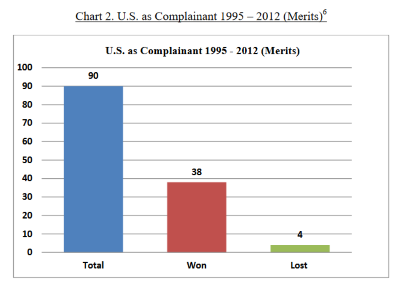
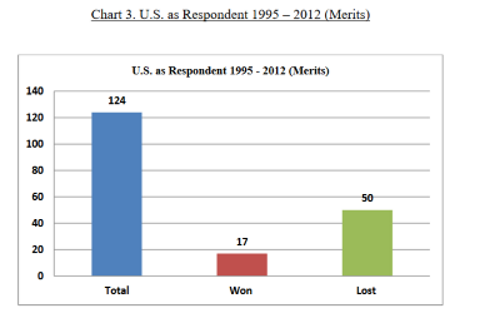
“Trump Wrong About WTO Record,” Oct. 27, 2017
Again, we encourage readers to also check out the articles on trade from our fact-checking colleagues throughout North America.
